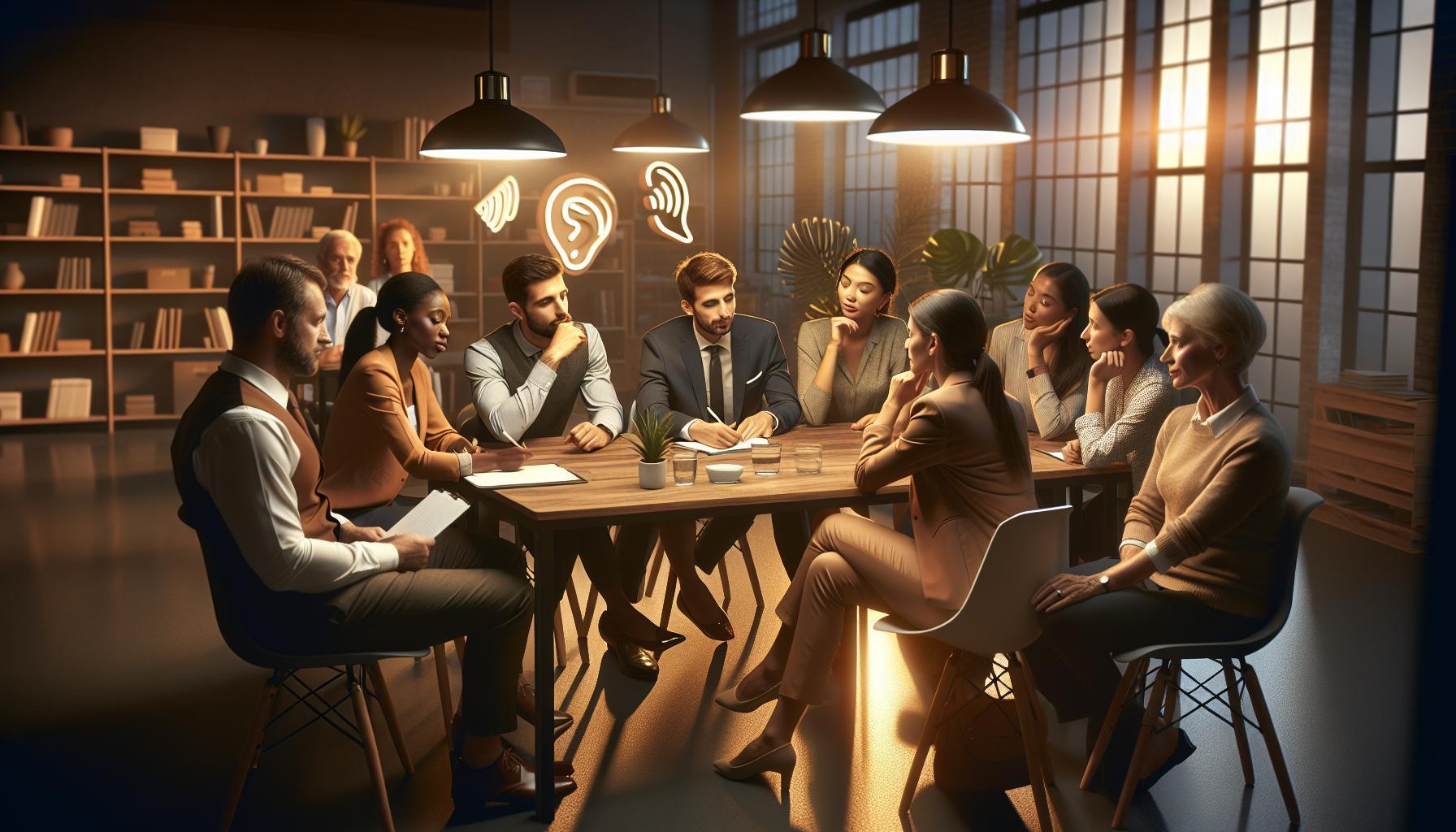Listening is an often-overlooked yet crucial skill for success in both personal and professional life. Struggling to connect with others or feeling misunderstood can stem from inadequate listening skills. By developing these abilities, you can enhance your relationships, avoid conflicts, and foster a supportive environment.
In the upcoming sections, we will explore practical activities designed to refine your listening skills, making them more effective in everyday interactions. Whether you’re a parent seeking to communicate better with your children, a professional aiming to improve team dynamics, or simply someone wishing to deepen personal connections, these tips will empower you. Get ready to unlock the art of listening, transforming your conversations into meaningful exchanges that enhance understanding and connection.
Activities to Enhance Active Listening Skills for Better Communication

Engaging in activities that enhance active listening skills can significantly transform communication and foster better relationships, both personally and professionally. Practical exercises not only cultivate awareness but also nurture empathy and understanding, which are fundamental in nurturing effective interactions. One effective approach is the “Paraphrasing Exercise,” where participants take turns sharing a story or experience. After one person speaks, the listener must paraphrase what they heard before responding. This practice encourages concentration and ensures that the listener is genuinely engaging with the speaker’s message.
Another valuable activity is the “Listening Walk.” Participants pair up and go for a walk in a quiet environment, taking turns to share thoughts or experiences. While one speaks, the other must listen attentively, focusing solely on the words without distractions. Afterward, they reflect on what they heard, noting key points and feelings expressed. This approach not only enhances listening skills but also helps build a deeper connection between the participants.
For a more dynamic group setting, consider group storytelling. Each participant contributes a sentence to a story, but they must incorporate elements from the previous participant’s contribution. This exercise encourages active listening and focus, as individuals must track the narrative and respond accordingly. Group activities like these can also boost confidence in communication and create a supportive atmosphere for developing vital listening skills.
Incorporating these activities into everyday interactions can help individuals develop a habit of active listening. By providing opportunities to practice in a structured yet enjoyable manner, participants can build skills that enhance their capacity for meaningful communication.
Essential Techniques for Practicing Listening in Daily Life
Active listening is a vital skill that can enhance communication across various settings, from casual conversations to professional meetings. By incorporating practical techniques into daily interactions, you can significantly improve your listening abilities. One effective method is the practice of “Reflective Listening,” where you paraphrase or summarize what the speaker has said to ensure understanding. This not only clarifies any misconceptions but also shows the speaker that their message is valued. For instance, if a colleague shares a project challenge, responding with, “So, you’re feeling overwhelmed by the deadlines and the workload?” reinforces your engagement and understanding.
Another powerful technique is to minimize distractions during conversations. This can be achieved by setting boundaries, such as silencing your phone or choosing a quiet environment for discussions. Furthermore, using positive body language is essential; maintaining eye contact, nodding occasionally, and leaning slightly forward can convey attentiveness and encourage the speaker to share more. To cultivate this, you might practice in low-stakes environments, like chatting with a friend over coffee or participating in community events where engaging with various people is encouraged.
Implementing open-ended questions can also facilitate deeper conversations and allow individuals to express their thoughts more freely. Instead of asking, “Did you enjoy the event?” try, “What did you find most interesting about the event?” This encourages a more meaningful dialogue and demonstrates genuine interest. Additionally, being mindful of your own responses is crucial. Allowing pauses after the speaker has finished can give you time to process their message and formulate a more thoughtful response.
By integrating these techniques into your everyday interactions, you can gradually build a habit of active listening that will improve both personal connections and professional relationships. Regularly practicing these skills not only enhances your engagement with others but also cultivates an environment of respect and understanding.
Transformative Listening Exercises for Collaborative Environments

In collaborative environments, fostering effective listening is crucial for creating a culture of respect and understanding. Engaging in transformative listening exercises can significantly enhance teamwork and communication skills. One such exercise is the “Circle of Voices,” where team members sit in a circle and take turns sharing their thoughts on a topic. The focus is on listening without interrupting, while the others practice maintaining eye contact and non-verbal engagement. After each person speaks, the others may briefly summarize what they heard to ensure comprehension, reinforcing active listening skills.
Another impactful exercise is “Role Reversal,” which encourages participants to step into each other’s shoes. Team members can pair up and discuss a current project from their partner’s perspective while embodying their feelings and opinions. After the discussion, partners share their reflections on how it felt to represent the other’s viewpoint. This practice not only improves empathy but also enhances gratitude for different perspectives, crucial for effective collaboration.
Additionally, incorporating “Listening Partnerships” can be transformative. In this setup, team members pair up and allocate time for one person to express their thoughts while the other listens actively without judgment. Afterward, the listener provides feedback on what they understood and how they felt about the conversation, which strengthens comprehension and connection. Such partnerships should be encouraged to occur regularly, creating a safe space for open dialogue and understanding.
By consistently incorporating these practices into team meetings or collaborative sessions, groups can cultivate a safe environment for sharing and encourage deeper connections. An atmosphere that values diverse perspectives ultimately leads to improved problem-solving and innovation. Over time, these exercises can transform how groups communicate, enhancing not only interpersonal relationships but also overall productivity and engagement.
Fun Games to Foster Listening Skills in Kids and Adults

Engaging in playful activities is a fantastic way to enhance listening skills among both kids and adults. One popular game is “Telephone,” where participants form a line or a circle, and the first person whispers a message to the next. This continues until the last person reveals what they heard, often leading to humorous misunderstandings. This game encourages players to listen carefully and understand nuances in communication, showcasing how easily messages can be distorted when not fully paid attention to.
Another effective activity is “Simon Says,” where one player gives commands beginning with “Simon says.” The twist is that players must only follow commands that are prefaced by the phrase. This game sharpens attention and listening abilities, as players need to differentiate between when to act and when to remain still. It fosters a keen sense of awareness and sharpens reaction times, making it a fun and dynamic way to develop listening prowess.
For a creative twist, consider “Story Building.” In this game, participants take turns adding one sentence to a story based on what the previous person said. This requires active listening to ensure that each contribution flows cohesively with the last. It not only enhances listening but also encourages imagination and collaboration. Players learn to value each contribution while also honing their ability to recall information accurately.
Finally, listening charades combines listening with active participation. One player listens to a prompt and must act it out while others guess what it is. This forces players to engage not only with the verbal cues but also with non-verbal communication, deepening their understanding of holistic listening skills. These engaging games are beneficial for people of all ages, making the learning process enjoyable and effective.
Mindfulness Practices to Improve Listening and Presence

Active listening is not just about hearing words; it encompasses being fully present in the moment. One powerful way to cultivate this presence is through mindfulness practices, which encourage an immersive experience in conversations. By incorporating mindfulness into your listening habits, you can improve your understanding and connection with others, ultimately enhancing your communication skills.
To begin, try the following techniques:
- Mindful Breathing: Before engaging in a conversation, take a few deep breaths to center yourself. Focus on your breath for a moment to clear your mind of distractions.
- Body Awareness: As you listen, pay attention to your body. Feel the weight of your feet on the ground and the contact of your body with the chair. This awareness can ground you, ensuring that you are present.
- Eye Contact: Maintain appropriate eye contact to show that you are engaged. This non-verbal cue reinforces your attention and encourages the speaker to share more openly.
- Reflective Listening: Practice summarizing what you have heard intermittently in the conversation. This not only demonstrates your engagement but allows the speaker to clarify points, ensuring mutual understanding.
Engaging in brief mindfulness exercises between conversations can significantly enhance your ability to listen actively. For instance, taking a moment to reflect on the emotions and thoughts you experienced during a conversation can deepen your empathy for the speaker’s perspective. Furthermore, consider practicing active listening in varied environments, such as during casual conversations, professional meetings, or even in group discussions. This variety not only sharpens your skills but also prepares you for diverse listening scenarios.
As you incorporate these mindful practices into your daily interactions, you will notice an increased ability to connect with others. Each conversation becomes an opportunity for growth, allowing you to foster deeper relationships and communicate more effectively. The journey of developing active listening skills through mindfulness can transform the way you engage, ensuring that each dialogue is as rewarding as it is meaningful.
Using Technology to Boost Your Listening Proficiency
In today’s digitized world, technology can be a powerful ally in enhancing your listening skills. Various tools and applications are designed to support active listening by promoting focused attention and refining comprehension. For instance, podcasts and audiobooks allow you to engage with diverse voices and narrative styles, enhancing your ability to process and retain information aurally. Listening to these resources at varied speeds can also challenge your comprehension skills, helping you to adapt and improve.
Utilizing interactive listening apps can further foster skill development. Many applications offer exercises that focus on specific listening attributes, such as summarizing, inferring, and questioning. Here are a few practical approaches:
- Listening Journals: Use digital note-taking applications to create a listening journal where you summarize key points from podcasts or meetings. This practice not only reinforces understanding but also creates a resource you can return to later.
- Speech-to-Text Tools: Leverage speech recognition software. Listening to recorded conversations and transcribing them can help sharpen attentiveness to nuance and detail in dialogue modes.
- Online Webinars and Workshops: Participate in online courses that involve active listening segments. Engaging with instructors and peers in real-time enhances your capacity to listen critically and respond appropriately.
Moreover, incorporating virtual reality (VR) sessions can create immersive experiences that heighten focus and sensory engagement. For example, VR environments that simulate public speaking scenarios can provide opportunities to practice listening under pressure, unveiling emotional cues and non-verbal signals you may need to discern in real-world situations.
By combining these technological resources with your daily listening practices, you can create a robust strategy to enhance your listening proficiency. With consistent engagement and the right tools, every conversation becomes a chance to deepen your skills and connections with others.
Real-World Scenarios: Applying Listening Skills Effectively
In any interaction, the ability to listen effectively can transform conversations and lead to more meaningful connections. Imagine sitting in a meeting where ideas are shared, yet the true essence often feeds through the nuances of dialogue rather than just the words spoken. Engaging in active listening practices allows you to not only grasp what is being communicated but also to uncover layers of intent and emotion behind those words. Here are practical strategies to apply listening skills in real-world scenarios:
1. Active Participation in Meetings
In professional settings, make it a point to summarize what others say before adding your own input. This reflects that you are engaged and comprehend their message. For example, during a brainstorming session, you might say, “So, what I hear you suggesting is…” This simple practice fosters clarity, encourages further discussion, and validates the speaker’s contributions.
2. One-on-One Conversations
When engaging in personal conversations, especially with family or friends, practice mirroring not just their words but their emotions as well. Use phrases like, “I can see this is really important to you,” to show understanding and empathy. This deepens your connection and encourages more open dialogue.
3. Community Engagement
Participate in community forums or group activities that require listening to diverse viewpoints. While discussing complex topics, such as community issues or shared projects, ensure everyone feels heard by practicing turn-taking in remarks. Invite quieter participants to share their thoughts, which not only enhances the discussion but also builds trust within the group.
4. Workshops and Role-Playing
Engage in workshops that use role-playing to simulate challenging conversations, such as delivering constructive feedback. By practicing these scenarios, you can refine your listening techniques and become adept at recognizing verbal and non-verbal cues in real-time interactions.
By integrating these approaches into your daily life, you strengthen your listening proficiency, making conversations more engaging and effective. Embrace every opportunity to practice active listening, as it is an invaluable skill that enhances relationships both personally and professionally.
Overcoming Common Barriers to Active Listening Success
Effective listening is often impeded by a range of barriers, both internal and external, that can hinder your ability to fully engage with others. Common distractions include competing conversations, environmental noise, and the overwhelming nature of multitasking. To mitigate these barriers, set the stage for success by creating a conducive listening environment. Choose locations that minimize background noise, establish clear boundaries for conversations, and eliminate digital distractions by silencing phones or closing unnecessary tabs on your devices.
Another significant barrier is the tendency to become preoccupied with forming your response rather than focusing on the speaker. This reflexive action can lead to misunderstandings and missed messages. To combat this, practice techniques such as pausing before responding. Allow yourself to reflect on what you’ve just heard, which not only provides you with time to construct a thoughtful reply but also demonstrates to the speaker that you value their input. Sharing what you understood with phrases like, “Just to clarify, you mean…” enhances this active listening practice, ensuring that any notions of discord are resolved early on.
Emotional barriers also play a crucial role in our listening capabilities. If you’re feeling stressed, upset, or defensive, your capacity to listen actively diminishes. Acknowledging your emotions and taking a few deep breaths before engaging in conversation can help center your thoughts. Recognize when your emotions may be clouding your judgment and use mindfulness techniques to regain focus. Furthermore, cultivating empathy by attempting to understand the speaker’s perspective can facilitate deeper connections and reduce defensiveness, allowing for a more enriching dialogue.
Lastly, fostering a feedback culture is essential for overcoming barriers to active listening. Encourage open conversations about listening habits among team members or within your family. This dialogue not only increases awareness of listening challenges but may also unveil solutions tailored to your unique context. Establishing regular check-ins can help maintain accountability and commitment to improving listening skills, making it an ongoing journey rather than a one-time effort. By proactively addressing these barriers and remaining committed to enhancing your listening ability, you’ll foster more productive and meaningful interactions.
Feedback and Reflection: Learning from Listening Experiences
Reflecting on listening experiences is essential for honing this vital skill. One strong method to enhance this reflection is through regular feedback sessions. These can be conducted after conversations, meetings, or group activities, where participants share observations about their listening practices. By creating a safe space for this exchange, individuals can gain valuable insights into their listening habits and identify specific areas for improvement. A structured approach can involve asking questions such as:
- What did you find most challenging about listening today?
- Were there moments when you felt you weren’t fully engaged? Why?
- How did your responses affect the speaker’s communication?
In addition to structured feedback, journaling about listening experiences can provide a personalized touch to learning. Keeping a listening journal allows individuals to jot down reflections after significant conversations. In this journal, one might note key points of the discussion, emotional responses, and their own engagement levels. This process helps to crystallize awareness around effective listening behaviors and highlights patterns that may lead to distractions or misunderstandings.
Finally, developing a habit of self-review is crucial. For instance, after a meeting or important conversation, take a few moments to assess your performance. Consider using a quick checklist:
- Did I maintain appropriate eye contact?
- Was I able to paraphrase key points to confirm understanding?
- Did I remember to ask follow-up questions that indicated genuine interest?
Engaging in this reflective practice not only increases accountability but also empowers individuals to course-correct and enhance their listening capabilities continuously. With patience and consistent effort, anyone can transform their listening experiences into meaningful learning opportunities that cultivate better communication and stronger relationships in both personal and professional contexts.
Integrating Listening Skills into Professional Development
Strengthening listening skills is essential for effective professional development, as it fosters better communication, collaboration, and problem-solving within teams. One impactful approach is to implement structured listening workshops or training sessions. These can include activities where participants practice active listening techniques in a controlled environment, such as role-playing scenarios that simulate workplace conversations. For instance, team members can pair up to share their thoughts on a project while the other listens without interrupting, then paraphrase what they’ve heard to confirm understanding. This not only enhances individual skills but also builds a culture of respect and open communication within the team.
Incorporating feedback mechanisms into regular performance reviews can also significantly improve listening competencies. Encouraging colleagues and supervisors to provide constructive feedback on listening behaviors promotes accountability and personal growth. A simple approach is to use a feedback form with specific questions focusing on listening skills, such as:
- How well did I articulate my understanding of the speaker’s points?
- Did I create an environment that encouraged open dialogue?
- How effectively did I handle interruptions or distractions during discussions?
Additionally, integrating listening goals into personal development plans helps individuals focus on skill improvements over time. Setting measurable objectives, such as “I will ask three clarifying questions in every meeting,” provides clear targets that encourage continuous practice.
Furthermore, diverse team settings can highlight the importance of listening across different cultural backgrounds. Providing training on cultural sensitivity in communication allows professionals to appreciate diverse perspectives and practices. This can be particularly valuable in global organizations, where understanding differences in communication styles is critical to achieving common goals. By cultivating an environment where listening is prioritized, organizations not only enhance their teamwork but also unleash innovative solutions rooted in collaborative thinking.
Listening in Diverse Environments: Strategies for All Situations
In today’s multicultural society, the ability to listen effectively across diverse environments is a crucial skill that can enhance both personal and professional relationships. Active listening goes beyond just hearing words; it involves being attuned to cultural nuances, body language, and emotional undertones that may differ significantly from one background to another. Embracing these differences fosters inclusive conversations and strengthens connections.
To develop listening skills that are adaptable to various cultural contexts, individuals can start by immersing themselves in different environments. This could involve participating in community events, attending workshops, or engaging with people from various backgrounds. During these interactions, utilize strategies such as mirroring-subtly copying body language or tone-to build rapport and show empathy. Additionally, practicing open-ended questioning encourages speakers to elaborate, providing deeper insights into their perspectives and experiences.
When navigating diverse conversations, it can also be beneficial to reflect on one’s own biases and assumptions. Maintaining a posture of curiosity allows for more open dialogue. Regularly engaging in self-reflection and seeking feedback on communication styles can illuminate areas for growth. Keep a journal to note specific communication encounters, identifying what worked well and what could improve. This process not only enhances self-awareness but also heightens sensitivity to others’ feelings and cultural expressions.
Furthermore, leveraging technology can be an effective way to enhance listening skills in diverse environments. Apps designed for language learning, for instance, can help break down language barriers, while virtual platforms can connect individuals across the globe, allowing for diverse conversations that enrich listening experiences. By engaging actively and reflectively with diverse perspectives, listeners can cultivate a richer understanding and foster more meaningful connections.
Measuring Your Progress: Tools and Techniques for Listening Improvement
To truly enhance your listening skills, it’s vital to measure your progress systematically. This process not only highlights your growth but also identifies areas where further improvement is needed. Start by setting specific goals for what you want to achieve with your listening skills. These could range from being able to summarize a conversation effectively to detecting subtle emotional cues in the speaker’s tone. Create a checklist to track these goals, ensuring each item is clear and actionable.
To facilitate ongoing improvement, consider engaging in self-assessments after conversations. Take a moment to reflect on your performance. Ask yourself questions such as:
- Did I fully understand the speaker’s message?
- Was I able to respond appropriately to their feelings?
- How engaged did I feel during the conversation?
Using a journal can help you document your reflections over time, creating a valuable repository of insights that can guide your development.
Additionally, seek feedback from trusted peers or mentors regarding your listening abilities. This feedback can provide an external perspective on how you listen and react. You might ask them to observe a conversation and then discuss their impressions. Consider creating a feedback form that includes specific attributes such as attentiveness, empathy, and clarity of responses. This structured approach will enable you to measure your progress quantitatively, making it easier to track changes over time.
Leveraging technology can also aid in measuring your listening skills. Many apps are designed to facilitate active listening practices, offering quizzes and challenges that test your comprehension and responsiveness. These tools can provide valuable analytics that highlight areas of strength and where you need improvement. Regularly engage with these resources, and embrace the journey of growth with an open mind. With consistent effort and reflection, your active listening skills will flourish, enhancing your personal and professional relationships.
Frequently asked questions
Q: What activities can improve listening skills in children?
A: Engaging children in interactive games like “Simon Says” or storytelling activities can significantly enhance their listening skills. Encourage them to recount stories in their own words to ensure comprehension, as detailed in the section on fun games for kids.
Q: How can mindfulness practices enhance listening abilities?
A: Mindfulness practices, such as focused breathing and meditation, improve mental presence, allowing individuals to listen more attentively. Regularly incorporating these techniques into daily routines can facilitate better communication, as noted in the mindfulness practices section.
Q: What are some quick exercises to develop active listening in the workplace?
A: Simple exercises like paraphrasing what colleagues say or summarizing team discussions can bolster active listening skills in professional settings. Consider integrating these into your regular meetings to foster better collaboration, which is discussed further in the real-world scenarios section.
Q: How does technology aid in improving listening skills?
A: Technology tools like podcasts and audio books can provide excellent resources for developing listening skills. Actively engaging with these materials and taking notes can enhance auditory comprehension, as outlined in the technology section of the article.
Q: What strategies can help overcome barriers to effective listening?
A: To combat distractions, try creating a dedicated listening environment and using techniques like note-taking during conversations. Building awareness of personal barriers will improve listening outcomes significantly, as addressed in the overcoming barriers section.
Q: When is the best time to practice listening skills in everyday life?
A: Practicing listening skills during routine interactions, such as family meals or coffee breaks, allows for natural development in less formal settings. Consistent daily practice helps reinforce these essential skills, as highlighted in the essential techniques section.
Q: How can feedback improve listening skills?
A: Seeking feedback from peers about your listening can reveal blind spots and encourage growth. Regular reflection on these experiences, as mentioned in the feedback and reflection section, fosters continuous improvement and skill enhancement.
Q: Why is integrating listening skills into professional development important?
A: Incorporating effective listening into professional development enhances teamwork and communication strategies, ultimately leading to increased productivity. This integration is crucial for success in diverse business environments, as discussed in the integration into professional development section.
Insights and Conclusions
Thank you for exploring our practical tips for developing listening skills! Remember, enhancing your listening abilities is a journey that requires consistent practice and application in everyday situations. As you implement these activities, you’ll not only improve your communication but also strengthen your connections with others. Don’t miss out on our other resources, like “Effective Communication Techniques” and “Engaging Activities for Team Collaboration,” which can further enrich your skill set.
We encourage you to take the next step-consider signing up for our newsletter to receive exclusive insights and updates that will keep you motivated on your path to mastery. If you have any thoughts or personal experiences to share, leave a comment below; we love to hear from you! Join us as you embark on this rewarding journey-your growth starts today!





